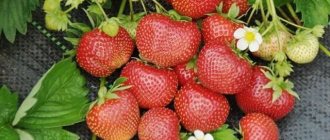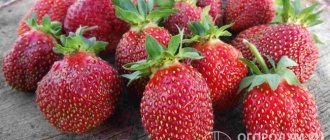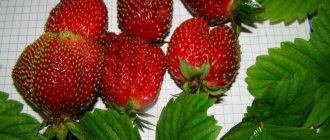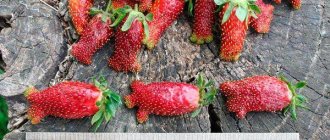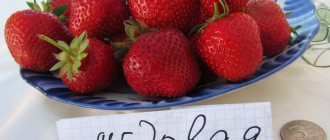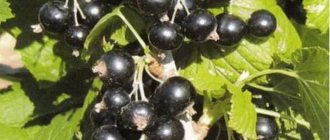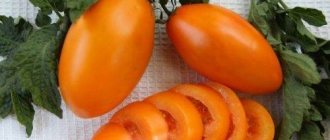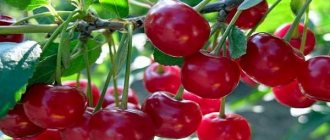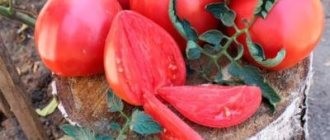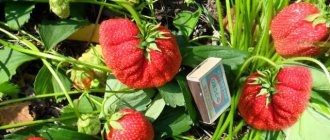A new product, a serious competitor to many proven day-neutral varieties, Murano strawberries, both in the field and indoors, are a grateful crop that generously produces large, glossy and aromatic berries of enormous size.
Increased productivity and excellent transportability deserve special attention. Such varieties do not appear often. Each of its seedlings is worth its weight in gold, because everyone who wants to make money growing strawberries dreams of growing such a wonderful variety.
Breeding history
The strawberry variety Murano is a product of Italian selection. Was derived in 2005 from the original non-proprietary forms R6R1-26 and A030-12. The copyright holder is Consorzio Italiano Vivaisti. For several years, a variety of remontant strawberries has been tested in European countries. A patent for the plant was issued in 2012.
During the tests, Murano strawberries showed themselves to be worthy not only in open ground, but also with a lack of lighting in a continental climate, including in various regions of Russia.
You can use any conditions for growing:
- open and protected ground;
- tunnels;
- hydroponics;
- multi-level systems.
Diseases, pests and prevention
The crop is susceptible to diseases and pests. Murano strawberries are no exception. There is no universal remedy against unfavorable cases. Therefore, only a complex of chemicals will help the gardener.
Colloidal sulfur is used against powdery mildew. It also fights spider mites. Bordeaux mixture and iron sulfate will get rid of rot and spotting. Copper sulfate has proven itself against fungal spores. Among folk remedies, iodine-milk solution, garlic and onion tincture, ash or mustard powder are used.
Description
Remontant strawberry Murano is a day-neutral variety. The bushes are compact and erect. The plant is medium-sized, up to 30 cm high, 45-50 cm in diameter. The leaves are large, rich green, there are few of them. There are only 2-3 tendrils on strawberries of the Murano variety, but they are viable and take root on their own.
Peduncles are powerful with a large number of buds. They are located just above the outlet. Flowers with 5-6 white petals stand out for their size: about 3.7 cm in diameter. About a month passes from the beginning of flowering to the picking of berries.
The fruits are regular cone-shaped, slightly elongated. The average weight of berries declared by the originators of the Murano strawberry variety is from 20 to 25 g, but with proper agricultural technology there are specimens weighing 35 grams or more.
Up to 1100 g of sweet fruits are harvested from one bush during the season. A peculiarity of the fruiting of this variety is some shrinkage of the berries towards the end of the growing season, but this is insignificant. It does not affect the taste and product characteristics in any way.
Berries with shiny glossy skin of bright red color. This is clearly visible in the photo. The pulp is juicy, dense, fleshy, with a pronounced aroma.
Important! Despite the density, there is no crunch when eating.
The transportability of Murano berries is high, for which it is especially valued by farmers who grow strawberries for sale.
Advantages and disadvantages of the variety
In addition to descriptions and characteristics when choosing strawberries, gardeners pay attention to the pros and cons of the variety. Murano has many more advantages than disadvantages. The proof is in the table.
| Advantages | Flaws |
| Early ripening | The presence of a small number of whiskers, which makes reproduction difficult |
| Abundant and long-lasting fruiting. Several harvest waves | High cost of planting material |
| Easy care | |
| Possibility to grow in any conditions, even in low light conditions | |
| Excellent taste properties | |
| High transportability and preservation of presentation | |
| Possibility of reproduction in different ways | |
| High-yielding variety | |
| Resistance to many crop diseases Excellent immunity to brown and white spot |
Neutral fruiting variety Murano:
a brief description of
Murano is considered one of the leading strawberry varieties in many respects. What is so good about Italian berries?
Advantages of the variety
- productivity is above average;
- blooms and bears fruit even in low light conditions;
- compactness of the bush;
- high commercial qualities of fruits: size, regular shape of berries, delicate aroma, density, keeping quality, transportability;
- early ripening of the first harvest;
- long harvest, Murano bears fruit until frost;
- the plant can be placed both in open ground and in a greenhouse;
- despite the density of the pulp, it does not crunch, which is typical for many remontant varieties
- excellent taste characteristics;
- versatility of berries;
- resistance to most diseases and crop pests, especially spotting and spider mites;
- resistance to low temperatures, which allows you to grow strawberries in regions with less than favorable climatic conditions.
The variety also has disadvantages. Compared to other types of strawberries, Murano produces a small amount of tendrils. During a long drought, the berries on the bushes may dry out, and with prolonged rain or excessive watering there is a risk of developing root rot. It is worth noting the high price of planting material.
Reproduction methods
A feature of remontant strawberries of the Murano variety is the possibility of propagation by all known methods:
- mustache;
- dividing the bush;
- seeds.
Usami
The rooting of Murano strawberries is insufficient, so when using this method you need to root them in time. The mustache can be rooted directly in the soil, as in the photo below. Many gardeners advise immediately placing the emerging mustaches in cups in order to separate them from the mother bush as soon as possible. In this case, propagation will not greatly affect the fruiting of strawberries.
Advice! The best plants for producing mustaches are selected in the garden bed, and the rest of the bushes are plucked off so as not to reduce fruiting.
Dividing the bush
The strawberry variety Murano is interesting because the bush grows well, new rosettes immediately throw out flower stalks. By the time of propagation, the bushes can be divided into parts. Each division should have a good heart and a developed root system. Strawberries are propagated by dividing the bush after fruiting is complete. As a rule, the peak of work occurs in the fall.
Attention! It is recommended to replant Murano strawberries annually.
But many gardeners who have been growing a remontant variety for several years believe that this is unjustified: strawberries give a good harvest in the 3rd and 4th year.
Growing from seeds
The seed method of propagating Murano strawberries is also acceptable, but it is more labor-intensive. Seeds should be sown in late January-early February. Then take care of the seedlings. But the main difficulty is not even the difficulty of seed germination, but the lack of light. Young shoots, despite the fact that the Murano variety is a day-neutral plant, will still have to be illuminated with special phytolamps at first.
Attention! Detailed information about growing strawberries from seeds, stratification and caring for seedlings.
Plant propagation
Strawberry bushes reproduce in several ways:
- dropping a mustache;
- separation of the daughter bush from the mother bush;
- seeds.
A small number of tendrils in the Murano variety requires timely rooting. To do this, you need to sprinkle the shoot with soil in the garden bed or place it in a cup. The latter method facilitates the process of separation from the mother bush.
The bush itself grows well and forms young rosettes. After fruiting, the strawberries are divided and propagated into separate bushes. Using seeds is a difficult way to propagate a variety. He is meticulous in caring for small sprouts.
Landing
Its further development and productivity depend on the correct planting of Murano variety strawberries.
Attention! Detailed information about the technology of growing strawberries in open ground.
How to choose seedlings
Selecting seedlings is not an easy matter. If you already have Murano strawberry bushes growing on your site, then you can fill the beds with the plants you have obtained yourself. If the plant is purchased in nurseries or specialized stores, you need to take a close look at them. The fact is that strawberry seedlings of this variety are not cheap.
There are rules for choosing seedlings:
- Seedlings must have at least three true green leaves and a flexible root system.
- The roots should not be less than 7 cm in length and 6-8 mm in diameter.
Site selection and soil preparation
The Murano strawberry variety prefers neutral soil. Acidic and marshy areas are not suitable for cultivation. Seedlings are planted on a hill so that groundwater is not higher than 1.5 meters. Only in this case can you get healthy plants with abundant fruiting.
Planting scheme
Judging by the description, the bushes of the Murano variety are compact, so it is not necessary to leave large gaps between them. Plants can be planted in one or two lines. Strawberries are planted according to a 30x30 cm pattern, although 25 cm is possible.
Caring for Murano strawberries
The plant should not be abandoned after planting. Like any other crop, it will need watering, fertilizing, weeding, and mulching. When leaving bushes to winter in open ground, care should be taken to mulch and cover them. Proper care will provide the plant with strong immunity and high yield.
Watering
Breeders of the Murano variety claim that these berries are heat-resistant. But this does not mean that they do not need regular watering. A good solution is to provide drip watering to the plants. The frequency of watering should be at least once a week. In dry summers, the frequency of irrigation is increased up to 3 times. Mulching the roots and creating shade will also help withstand the heat.
Fertilizer
To improve plant health, it is worth applying fertilizers on time. Such events are held several times a season. It should be noted that strawberries need both root and foliar feeding. In early spring, nitrogen compounds are added to the plants.
After the first flower stalks appear, the leaves are provided with a sufficient amount of potassium, phosphorus, manganese and iron. This composition is re-fed after 3-4 weeks. As a pre-winter preparation, the plant is fed with mineral complexes based on potassium and phosphorus. Nitrogen fertilizers reduce resistance to winter cold, so they should not be applied in the fall.
Weeding and loosening
If the bushes were planted in open ground and not under spunbond, weeding and loosening will become mandatory maintenance measures. Strawberry bushes do not tolerate proximity to weeds. The berries will become small and unsweetened. Therefore, at least 6-8 weedings are carried out per season.
Loosening allows the roots to be saturated with oxygen, which has a beneficial effect on plant development. Tillage is carried out around the bushes to a depth of up to 4 cm and between the beds - up to 10 cm. This activity is also combined with the application of fertilizers. You should not carry out these procedures during flowering so that pollen does not fall off from the flowers.
Mulching
This action helps reduce the number of weedings. Mulching also maintains the fertile properties of strawberries. The optimal period for the procedure is the appearance of the first flowers. This is explained by the fact that in early spring the soil should warm up well.
Wintering
After fruiting, the strawberries are prepared for the winter. Cut off the leaves and tendrils, leaving no more than 10 cm of the stem. Before the first snow falls, the plant will have time to grow several leaves.
The next step is treatment with chemicals that protect against pests and diseases. After this, potassium-phosphorus fertilizer is applied and mulched. Peat is suitable as winter mulch. Before the onset of cold weather, water the plant so that the roots have enough moisture. In cold regions, a shelter is created from pine branches or stretched spunbond.
Care
No special knowledge or skills are required when caring for Murano strawberries. All agrotechnical measures are exactly the same as for other representatives of this culture.
Spring period
In the spring, when the plants are just waking up, old leaves are removed and water-recharging irrigation is carried out. At the same time, strawberries are fed with nitrogen-containing fertilizers.
Watering and mulching
The originators of the variety, Italian breeders, indicate that Murano strawberries are heat-resistant and can easily tolerate short-term heat. But to preserve moisture in the soil and its looseness, it is recommended to mulch the root zone of the plant with a special mulching agro-fabric or straw. In addition, in extreme heat, plantings must be shaded.
Murano strawberries should be watered moderately, as excess moisture leads to the death of the root system. At the time of fruiting, you need to water more often. Once a week, half a bucket of water is poured under the bush.
Advice! It is best to use a drip irrigation system to water the bushes.
Fertilizing
Strawberries of the Murano variety are fed several times a season, using root and foliar feeding:
- In early spring there is a need for nitrogen fertilizers.
- When the first flowers appear, then every 21-28 days, water the plants on the leaves with mineral complexes containing potassium, phosphorus, manganese, and iron.
- After harvesting, before preparing for winter, mineral complexes containing phosphorus and potassium are added.
Comment! Nitrogen fertilizers are not applied before winter so as not to reduce the winter hardiness of strawberries.
Detailed information about root and foliar feeding of strawberries.
Preparing for winter
Before covering the strawberries, sanitary cleaning and fertilizing are carried out. The bushes must be mulched to prevent the root system from freezing. Since the Murano variety is a heat-loving plant, in regions with severe frosts, plantings are covered with agrofibre. If necessary, add a layer of earth on top.
Attention! Proper covering of strawberry beds is the key to a harvest.
Tips for feeding plants
Experts advise feeding Murano berries several times a season. The key points are the following periods:
- In early spring, the plant needs fertilizers that contain nitrogen.
- After the flowers appear, the addition of mineral complexes will be required.
- In preparation for the winter season, the plant will need fertilizers such as phosphorus and potassium, as well as a number of organic matter.
The crop does not need nitrogen types of fertilizers in autumn; they can reduce its resistance to frost.
Pests and ways to combat them
| Pests | Signs | Control measures | Prevention |
| Weevil | Flowers bloom, but the ovary is missing | To spray plantings, use Karbofos, Actellik, Corsair or Zolon | |
| Slugs | Damaged leaves, berries, visible slippery mark | treat plantings with Groza, Meta | Sprinkle superphosphate or potassium salt around the bushes. Spray the plantings with a solution of table salt |
| Nematode | Yellowing and curling leaves, plants grow slowly, berries are ugly | Treatment with Lindane, Phosphamtide, Heterophos If all else fails, destruction of plants and burning | Fertilize the beds with manure, and before planting, immerse the seedlings in hot water at a temperature of 50 degrees |
| Ants | They damage the root system and breed aphids in strawberry plantings. | Spraying plants and soil with Fitoverm, Aktara, Iskra | Pour a solution of boric acid, garlic infusion, yeast |
| Strawberry mite | The leaves become smaller, curl, the berries dry out | Infected bushes must be removed |
Attention! Detailed information about strawberry pests.
Cleaning and storage
Harvesting takes place a couple of days before true ripeness. This helps keep the strawberries fresh for several days. The berries are removed from the bush along with a small tail. Otherwise, the fruits will quickly deteriorate. It is better to carry out this procedure after the morning dew disappears or before sunset.
Store the harvest in wooden or plastic boxes. The bottom is covered with soft cloth or paper. The berries are placed in one layer and then cooled at a temperature of 0 – +2. The berries are frozen or canned.
Murano strawberries have a good description of the variety, which is true. The berries are large and fragrant. The bushes are compact, which allows you to place more plants in a small area. The variety is easy to care for and tolerates short daylight hours and cold climates.
Features of cultivation
Murano does not require special conditions for planting. This is the least capricious strawberry variety that even an inexperienced gardener can handle.
Climatic conditions
This variety is ideal for growing in continental climates. It can withstand both low and high temperatures quite calmly. It is enough to cover the plant for the winter and provide regular watering in the summer.
Description of the variety
Murano strawberries are one of the most delicious, productive and versatile varieties. It is a remontant variety. Ripens very early.
Murano's bushes are small and compact. There are relatively few leaves on the plant. Due to its compactness, a fairly large number of bushes can be planted in a small area.
The leaf blades are bright green in color and relatively small. Peduncles are located under the leaves.
The flowers of this strawberry are large and bisexual. This means that Murano does not need an additional pollinator.
The berries are red-orange in color, very beautiful, medium in size. The berries have a conical shape.
The pulp is dense, but at the same time very juicy. The fruit does not crunch when bitten. The taste of the berries is excellent. They are sweet, with a slight hint of sourness.
The average weight of a mature fruit reaches 25 grams. Sometimes larger specimens are found, weighing up to 35-40 grams.
The surface of the berry is glossy, covered with a large number of small achenes.
Despite the relatively small mass of berries, the variety is quite productive. From 1 bush you can harvest about 0.9-1.1 kg of crop. Naturally, such high rates are achieved only with good care.
The fruits, due to their good density, are very well transported over long distances. Also, they are stored for quite a long time. The combination of these qualities makes strawberries very popular in commercial circles.
Another advantage of this variety is its good frost resistance and fairly strong immunity, which helps the crop fight a number of strawberry diseases.
Proper planting of strawberries
Before planting strawberries, you need to do some preparatory work. First, you need to select a site and prepare it well. Secondly, you need to choose high-quality planting material.
As for the site, choose a sunny place, protected from northern winds. Water in the area should not lie close to the surface. On the site, weeds are first removed, it is plowed (dug up) and fertilized with organic matter. It is best to fertilize the site a month before planting begins. As a last resort - two weeks before the planned planting of strawberries.
As for seedlings, they need to be carefully selected. Unfortunately, this is difficult to do on the market, since the choice with this variety is often limited
In any case, when choosing, you need to pay attention to:
- Leaves. The seedlings must have at least three true green leaves.
- Roots. The root system must be flexible, at least 7 cm in length.
- The plant should not have visible defects in the form of spots, cracks, growths, etc.
After the site and seedlings have been selected, you can begin directly planting the crop. The planting pattern is standard, the same as for any other strawberry:
- The first step is to dig out the planting holes.
- It is recommended to make the distance between the holes at least 30 cm. The distance between the rows is about 60-70 cm. This will allow you to care for the crop without any problems and will simplify further harvesting.
- After this, the holes are watered.
- When the water is absorbed, you can place the seedling in the hole.
- The seedling is placed strictly in a vertical position. The root system is carefully straightened in the hole. Many gardeners recommend making a small mound in the center of the hole, which will make it easier to straighten the roots of the plant.
- After the seedling is placed in the hole, it is sprinkled with soil. The soil is compacted.
- At the end of planting, each bush is watered again.
Growing and care
The agricultural technology of the Murano variety is practically no different from the standard rules for caring for strawberries.
Watering
Watering is carried out once a week; about 3-5 liters are enough for one plant. During drought, the amount of moisture needs to be increased, since the roots of strawberries are located near the surface, a periodicity of 3-4 days will be optimal. Strawberries should also not be overwatered, as the root system can rot from excess moisture.
To retain moisture in the soil, the latter must be covered with a layer of mulch, especially during periods of prolonged heat. Mulching will also reduce the number of weeds on the site. Don’t forget about loosening the soil - the procedure will improve oxygen access to the roots and destroy weeds in the early stages of development.
To maximize fruiting, gardeners separate beds with mother and fruiting bushes. In the first case, the work goes to growing the mustache, in the second they are cut off to get the maximum yield.
Top dressing
For record fruiting and to avoid diseases, Murano strawberries must be fed. Fertilizer application depends on the season:
- In the spring, the beginning of the growing season is stimulated by the introduction of a nitrogen complex. Humus is suitable (a bucket per m2), watered with a solution of mullein (1:10), bird droppings (1:20)
- During flowering and fruiting, the plant needs potassium-phosphorus fertilizers. You can use ordinary wood ash at the rate of 150-200 g per m2.
- The last feeding is after harvesting. During this period, the plant again needs phosphorus and potassium.
Pest and disease control
A small amount of foliage reduces the risk of strawberries being damaged by fungi and pests. Nevertheless, one should not forget about preventive procedures. This includes timely sanitary cleaning of the soil, mulching, fertilization, and protection from waterlogging and drying out.
What diseases can Italian strawberries suffer from:
- Powdery mildew - white coating and leaf curling. The fungus is treated by spraying with a solution of copper sulfate - 30 g per 10 l, or with a special fungicide.
- Gray rot is the appearance of a gray fungal coating on the fruit. Most of the crop may be lost. Treatment and prevention - spraying with a solution of colloidal sulfur or a fungicide.
- Brown spot (very rare) is a copper coating on the leaves that causes massive drying out of plantings. Fight - watering with a solution of potassium permanganate - 3 g per 10 liters.
Popular strawberry pests:
- Slugs are parasites that feed on leaves and berries. Spraying them with a solution of table salt and distributing superphosphate around the bush will help eliminate them from the bush.
- Nematodes cause leaf curl and abnormal berry development. If treatment with insecticides does not help, you will have to destroy the plant.
The Murano variety is practically not affected by spider mites.
Preparing for winter
Murano strawberries are frost resistant. Temperatures above -24 degrees. withstands under a blanket of snow. In the absence of snow and severe frosts, it is recommended to mulch the plantings generously and cover them with spruce branches and dense agrofibre.
History of creation
The day-neutral variety Albion was developed in 1997 by breeders Douglas W. Shaw and Kirk D. Larson. The Diamant varieties were crossed with the numbered selection Cal 94−16−1. The resulting plants were assigned the number Cal 97.117−3 and planted at the University of California's Wolfskill Experimental Orchard near Winters. There, in 1998, the first harvest was obtained, then asexual reproduction was carried out using rosettes formed on the tendrils that strawberries produce. After selection and testing, the new variety was given the number CN220 and later given the name "Albion". This word itself is of Celtic origin and denotes the ancient name of the British Isles.
In 1999, our hero was tested at the Watsonville Strawberry Research Facility, the South Coast Research and Extension Center, and limited planting of strawberries began in the fields. After the scientists were convinced that the varietal characteristics were fixed and preserved during subsequent reproductions, the registration procedure began and plant testing continued for various parameters. In 2004, the first patent for the variety was received. Albion officially belongs to the University of California, USA.
Proper care of strawberries
The quality of the harvest depends on the gardener. The better he takes care of the crop, the more berries each bush will produce and the less often the crop will get sick. The basis of care is timely watering and fertilizing. Naturally, in addition, you need to loosen the soil, remove weeds, etc. But the basis is watering and fertilizing.
Watering
As a standard, strawberries are watered only once a week. It is best to use a drip irrigation system for this. If this is not possible, water the strawberries in the morning or evening (when solar activity is reduced), pouring water directly under the root. The water should be settled and warm. It is unacceptable to use water directly from the well.
If it is very hot outside, then the number of waterings is increased to 2-3 per week (sometimes more, depending on the speed of soil drying).
After each watering, it is advisable to loosen the soil. This will saturate the root system with vital oxygen.
Fertilizer
As noted earlier, fertilizing plays an important role in caring for strawberries. On unfertilized soil, strawberries grow tasteless, small, weak, etc.
We also recommend reading: Description of the strawberry variety Mitze Schindler
Fertilize strawberries only 3 times per season:
- The first time was in early spring, immediately after the bushes woke up from their winter sleep. During this period, the plant needs nitrogen, which stimulates the growth of the green part.
- The second time strawberries are fed immediately after flowering. This time you can use phosphorus-potassium fertilizers.
- After harvesting, in order to prepare the bushes for wintering, they are additionally fertilized with organic matter.
Strawberry Murano as queen of neutrals
Everything about the Murano strawberry variety - characteristics, description, brief and succinct morphological characteristics, reviews from gardeners and farmers about the Italian beauty.
Murano strawberries - what is important to know about Italian
Tests over a period of 5 years in various regions of Europe have proven its suitability for cultivation in a continental climate, sufficient winter hardiness, and high yield in conditions of artificial and insufficient lighting. In regions where the end of the growing season falls on early frosts - in the Moscow region, in the Urals, it is advisable to use shelter in the form of arcs and other non-stationary structures to collect the last harvest. Recommended for cultivation in open ground and indoors, it has shown itself well in field conditions, in heated film greenhouses, tunnels, and is suitable for cultivation using hydroponics, in multi-level systems.
Neutral daylight hours - gives many waves of fruiting. The fruiting period for remontant Murano strawberries is from the beginning of June, along with mid-early ones, and until September-October, until frost. In the northern regions, the last berries go into winter.
In the photo, Murano strawberries are singing, August
- The bush is medium-sized, compact, erect, with little foliage, average height up to 0.3 m, width about 45-50 cm.
- The flowers are large - up to 3.7 cm in diameter with 5-6 petals, white, located above or at the level of the leaves.
- From flowering to harvesting is about 28-32 days.
- The whisker formation is moderate - it does not form many whiskers, but somewhat more than Ischia.
- The average fruit weight according to the originator's request is up to 20-25 g, but in practice with sufficient feeding it is up to 30-35 g and above. The declared yield is up to 1.1 kg per plant.
- The fruits are large, of a regular conical shape - chiseled, verified. The first berries may have a slightly changed shape, the subsequent ones may have a regular elongated shape. The berries of the latest harvest may be somewhat smaller, but the difference is insignificant.
- The skin is bright red, shiny, the flesh is red, high density. The taste is sweet, multifaceted, pronounced aroma - gender neutral to the Albion, Monterey type, alas, but somewhat inferior. Fully develops flavor and gains sugar when fully ripe. The strawberries themselves are inferior to Charolotte, Mara de bois and some other rare exceptions, while clearly surpassing them in yield. It doesn’t crunch like many hard-fruited ones like San Andreas, it doesn’t fall into the container with a ringing sound like Evy - it’s just very dense, heavy, but juicy and meaty.
- It is resistant to major diseases; according to reviews, it is especially distinguished by its resistance to fungal spots - brown and white spots.
We grow: planting, care
Like every variety, Murana strawberries have their own characteristics - everything about cultivation and care, subtleties and nuances.
For garden cultivation and small-volume production, due to the compressed habit of the bush, it is possible to plant according to a 30x30 cm pattern, which is too dense for leafier plants. On industrial plantations, compaction of up to 25 cm between plants is possible - when the feeding area is reduced, the application of fertilizing is adjusted accordingly.
- It is positioned as a heat-resistant variety that performs well in hot weather, but to maintain soil moisture and looseness, be sure to mulch the root zone. She will respond with gratitude to shading - most day-neutral varieties look like normal plants only in August, but in dry July they suffer and wither, and are not particularly pleased with the berries.
- Will respond with gratitude to drip irrigation.
- You can’t call it too demanding of fertilizing - although in order for a bountiful harvest to ripen, it cannot do without sufficient fertilizing; it will not grow many mustaches - propagating Murano strawberries is not such an easy matter. It is advisable to divide the plantings: fruit-bearing bushes - in one bed, mother bushes, where flower stalks should be cut off - in another.
- At the beginning of flowering and during the ovary period, a nitrogen-mineral complex is introduced, the main components of the mineral part being potassium, phosphorus, manganese, iron. In early spring, root feeding is applied, then it is more convenient to use leaf fertilizers.
- Resistant to major diseases - it is difficult to blame it for excessive susceptibility to spotting and diseases of the root system.
- In the northern regions, it is advisable to grow late harvests in tunnels, under cover, or cover them using removable structures.
- For the winter - preventive sanitary cleaning, after fruiting - fertilizing. You shouldn’t add a lot of nitrogen before winter - there is an opinion that adding nitrogen to strawberries in the fall is fraught with a protracted growing season: dormant plants will end up directly exposed to frost. A heat-loving crop, it requires shelter for the winter - agrofibre, vegetable mulch.
Subtleties of growing crops
Breeders have stated that most modern varieties are unpretentious in care. But it is still necessary to fulfill simple agronomic requirements when planting and growing berries. After all, the development and productivity of plants depends on these rules. The Murano variety also needs attention.
Choosing the right seedlings
Planting strawberries will require some diligence. The first step is to choose suitable sprouts
The cost of future bushes is also taken into account
The variety has a high price, so it is important to inspect the seedlings before purchasing. It’s good if you have the opportunity to get young plants directly from the garden
But most often the bushes are sold in specialized stores or nurseries
It’s good if you have the opportunity to get young plants directly from the garden. But most often the bushes are sold in specialized stores or nurseries.
To choose a good strawberry sprout, follow two rules:
- The root system is developed and flexible. The length of the roots is at least 7 cm, thickness - up to 8 mm.
- A robust bush has more than three green leaves.
Disembarkation time
Experienced summer residents have noted that the best time to plant strawberry bushes is at the end of summer and beginning of autumn. This way the plant will take root better and undergo the hardening process during winter frosts. To speed up the harvest, bushes are planted in the spring. To protect against possible April frosts, plants are covered with agrofibre.
Landing place
For Murano strawberries, soils with a neutral acidity level are chosen. Do not plant berries in acidic or swampy areas
It is also important to monitor the groundwater level. They must be more than 1.5 meters from the roots of the plants
This condition ensures abundant fruiting and healthy plants. Strawberries are planted at higher elevations.
Planting process
Compact bushes are placed closer to each other than conventional varieties. The standard planting pattern for garden strawberries is 50 x 50 cm. For Murano, gardeners use a planting pattern of 30 x 30 cm, and in some cases 25 x 25 cm. The variety is perfect for beginning agronomists because it is undemanding in care.
When planting berries, it is important to take into account predecessors and the proximity of crops. Horseradish, sunflowers, buttercups, raspberries, and vegetables of the nightshade family are bad companions for strawberries in the garden.
Excellent predecessors will be dill, parsley, radishes, beans, legumes and garlic. It is also important to give the beds a break from strawberry plantings for 5 years.
